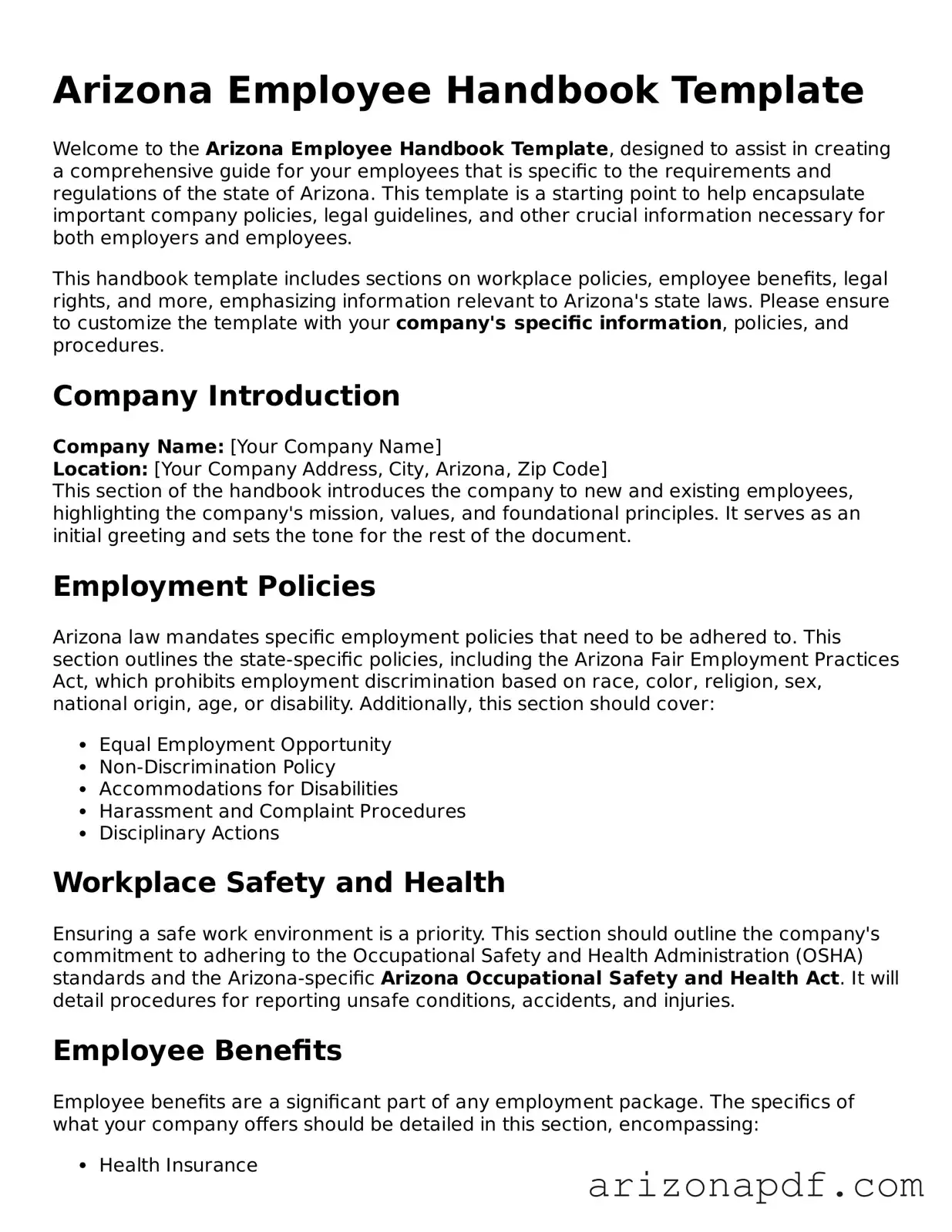What is the purpose of the Arizona Employee Handbook?
The Arizona Employee Handbook serves as a comprehensive guide for both employers and employees within the state, outlining policies, procedures, expectations, and rights in the workplace. It is designed to establish a clear understanding between parties, promote a positive work environment, and ensure that both employers and employees are aware of their legal obligations and protections under state and federal laws.
Is it legally required for businesses in Arizona to have an Employee Handbook?
No, there is no legal requirement in Arizona mandating businesses to create or maintain an Employee Handbook. However, having one is highly recommended as it can help protect businesses against potential legal disputes and clarify workplace standards and procedures for employees.
What key sections should be included in an Arizona Employee Handbook?
An effective Arizona Employee Handbook should include sections on employment policies (such as hiring practices and at-will employment), standards of conduct, anti-discrimination policies, compensation and benefits information, work hours and attendance rules, safety and security procedures, and descriptions of disciplinary and grievance procedures. It’s also beneficial to include a section on how the handbook will be updated over time.
Are there any specific policies that are required to be in the Arizona Employee Handbook?
While there are no specific policies required by Arizona law to be included in an Employee Handbook, it is advisable to incorporate policies that are reflective of federal and state employment laws. These include anti-discrimination and harassment policies, family and medical leave policies as applicable under the FMLA (for eligible employers), and accommodations for disabilities. Including an acknowledgment page for employees to sign is also recommended to confirm they have received and understood the handbook’s contents.
Can an Employee Handbook be considered a binding contract in Arizona?
Generally, an Employee Handbook is not considered a binding contract in Arizona if it includes a clear disclaimer stating that the handbook is for informational purposes only and does not constitute a contract. To avoid creating unintended contractual obligations, it is important for employers to carefully word their handbooks and clearly communicate that the document is meant to provide guidelines rather than serve as a contract.
How often should the Employee Handbook be updated?
It is best practice to review and potentially update the Employee Handbook annually. This ensures that the handbook remains current with any changes in company policies, as well as state and federal laws. Additionally, whenever significant legal or operational changes occur that affect employment practices, the handbook should be promptly updated to reflect these changes.
How should updates to the Employee Handbook be communicated to employees?
When updates to the Employee Handbook are made, it is crucial to communicate these changes to all employees clearly and promptly. This can be achieved through internal emails, staff meetings, or by providing employees with a summary of changes and a revised copy of the handbook. Having employees acknowledge the receipt and understanding of the updated handbook is also advisable.
Is it important to customize the Arizona Employee Handbook for different companies?
Yes, it is very important to customize the Employee Handbook to fit the specific needs, culture, and operations of each company. While many employment policies may be similar across different businesses, customizing the handbook allows a company to address unique aspects of its operations, employee expectations, and company culture, providing a more effective and meaningful guide for employees.
Can digital versions of the Employee Handbook be used instead of printed copies?
Digital versions of the Employee Handbook are acceptable and can be especially effective in ensuring easy access and distribution among employees. However, it is important to ensure that all employees have the necessary means to access the digital handbook and that measures are in place to confirm that each employee has reviewed and acknowledged the handbook, just as they would with a printed version.
What should an employer do if an employee violates a policy outlined in the Employee Handbook?
If an employee violates a policy outlined in the Employee Handbook, the employer should follow the disciplinary procedures detailed within the handbook. It is crucial that these procedures are applied consistently to all employees to maintain fairness and compliance with applicable laws. Depending on the severity of the violation, disciplinary actions may range from verbal warnings to termination of employment. Employers should also document all steps taken to address the violation.
